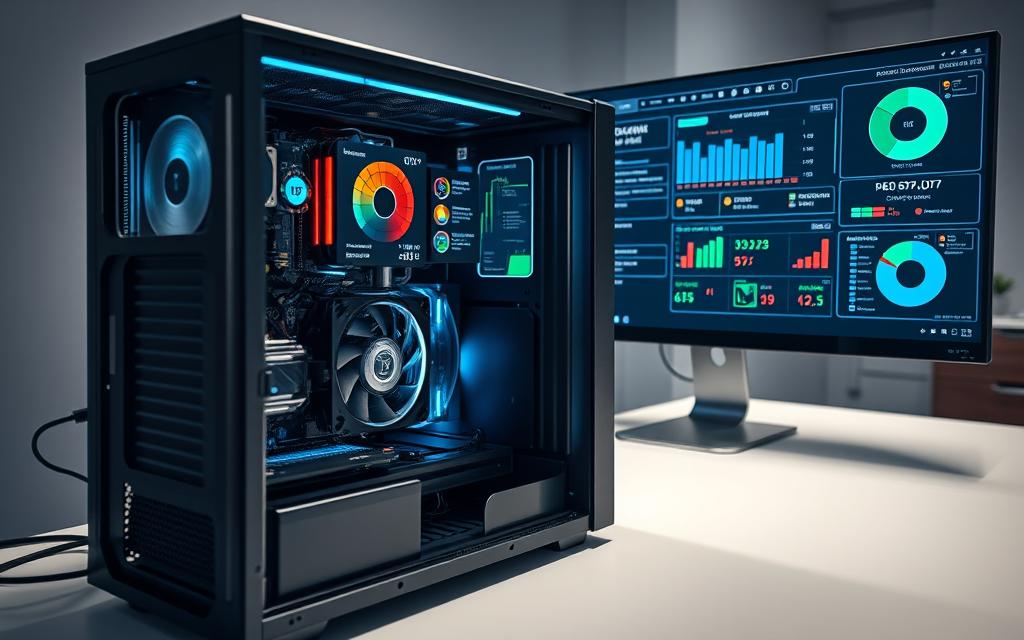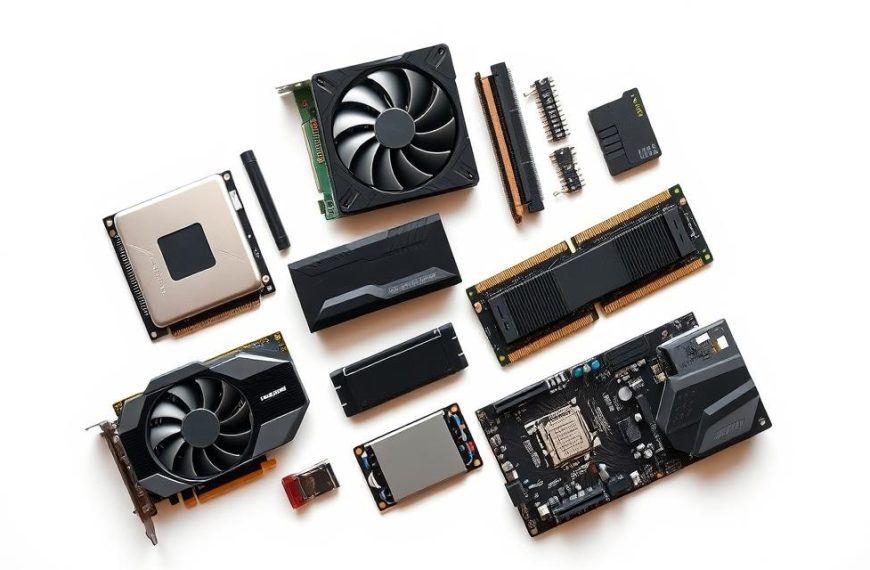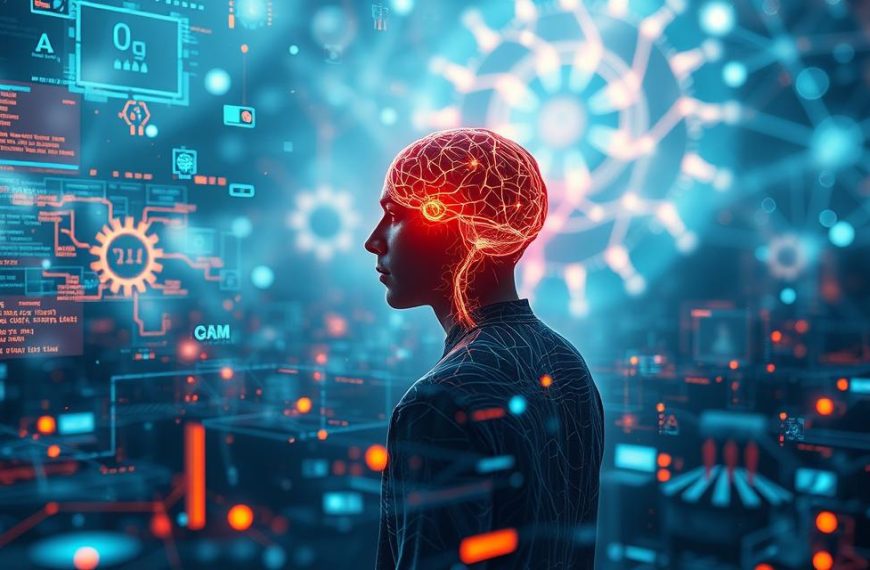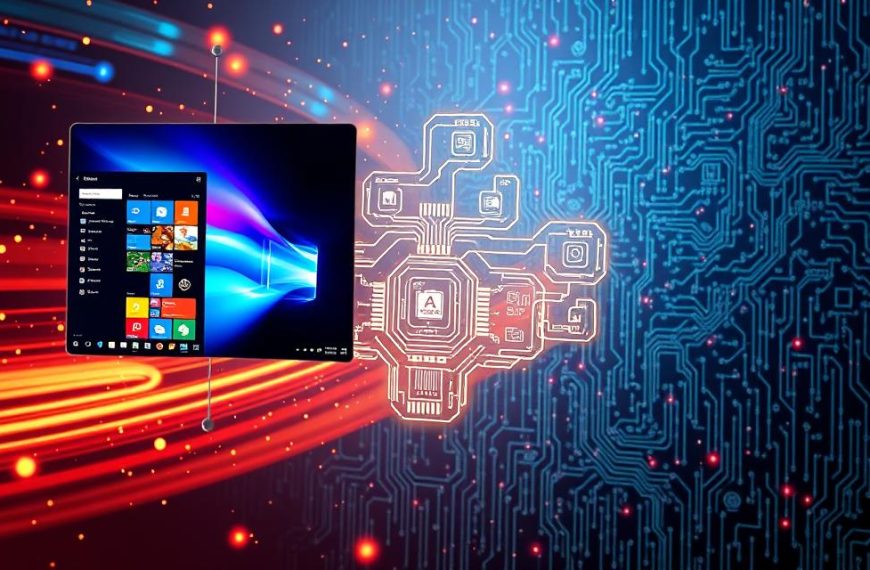Computer performance is vital for both work and personal use. Regular hardware checks can prevent system failures and keep your computer running smoothly. Testing your computer’s performance helps spot issues early on.
Modern computing needs a healthy system. Understanding hardware diagnostics is becoming more crucial. Computers depend on many parts working together well. Processor speed, RAM, and storage all affect overall performance.
A processor speed above 1.5GHz is best for efficient system operations. Diagnostic tools are key to maintaining computer health. Windows 10 offers built-in utilities for troubleshooting.
About 70% of users use these tools to solve problems. These tools help assess computer performance and find potential hardware issues. Regular checks can cut severe system problems by half.
Understanding and using thorough hardware testing is essential. It can extend your computer’s life and ensure reliable performance. Make hardware diagnostics a regular part of your computer care routine1.
Understanding Common PC Hardware Issues
PC hardware issues can greatly affect system performance and reliability. Knowing these problems helps prevent failures and keeps computers running smoothly2. Regular checks can save you from costly repairs.
Computers have many parts that can fail at any time. The most vulnerable components include GPUs, hard drives, SSDs, RAM, PSUs, cooling fans, and CPUs.
Most Frequent Hardware Failures
Hardware failures show various symptoms. Approximately 20% of PCs experience power-related issues, often due to cable or power supply problems3.
Key signs include sudden shutdowns, odd noises, and slower performance4. These can indicate serious hardware issues that need attention.
Signs of Hardware Malfunction
Spotting early warning signs is vital for component health. Look out for these symptoms:
- Unusual grinding or clicking sounds2
- Frequent system freezes3
- Blue Screen of Death (BSOD) occurrences3
- Unexpected performance slowdowns
Critical Components to Monitor
Regular checks on key hardware parts can prevent major failures. Proactive maintenance helps identify potential issues before they worsen.
Focus on tracking the health of your RAM, hard drives, cooling systems, and power supply4. These components are crucial for your PC’s performance.
Preventative care is always more cost-effective than emergency repairs.
Built-in Windows Diagnostic Tools
Windows offers powerful built-in tools to identify and fix hardware issues quickly. These Windows diagnostic tools help maintain top computer performance. They also prevent potential system failures5.
The Performance Monitor gives detailed insights into system resources and performance. It tracks various hardware components5.
- CPU utilisation
- Memory usage
- Disk activity
- Network performance
Windows Memory Diagnostic is crucial for spotting RAM-related issues6. It can automatically detect and test memory problems. Diagnostic tests usually take 20 to 30 minutes6.
Users can run the test to check for memory errors. These errors might affect system stability5.
Windows 11 offers advanced diagnostic features for many system parts5. The tools can spot issues with:
- Storage drives
- Graphics cards
- Network adapters
- CPU performance
Pro tip: Run these tools often to avoid unexpected system failures. Regular checks help keep your computer healthy5.
Proactive monitoring lets you tackle potential hardware issues early. This prevents small problems from becoming big ones.
How to Test My Computer Hardware?
Computer hardware testing keeps your system running smoothly. It helps spot potential issues early on. Regular checks can prevent unexpected failures and extend your computer’s life7.
A thorough approach covers multiple components. Common hardware failures include GPUs, hard drives, SSDs, RAM, power supply units, fans, and CPUs7.
Essential Testing Tools
Several powerful tools can help you test your computer hardware:
- Windows Memory Diagnostic (built-in tool)8
- MemTest86+ for RAM testing7
- CrystalDiskInfo for storage health7
- HWiNFO for detailed system reports7
Step-by-Step Testing Process
- Open Windows diagnostic tools8
- Select appropriate testing software
- Run comprehensive system scans
- Review diagnostic reports
Interpreting Test Results
Understanding test results requires knowledge of specific metrics and warning signs. Here are key areas to examine:
| Component | Key Diagnostic Indicators |
|---|---|
| RAM | Memory errors, read/write inconsistencies |
| Hard Drive | SMART status, reallocated sectors |
| CPU | Temperature, performance stability |
Professional diagnostic tools offer deep insights into system health. They help users make smart decisions about computer maintenance8.
Advanced Third-Party Diagnostic Software
Advanced hardware testing requires sophisticated third-party diagnostic software. These tools offer detailed insights into computer performance and component health9.
Third-party diagnostic software provides key advantages for in-depth system analysis:
- Real-time hardware monitoring
- Detailed performance graphing
- Comprehensive component reporting
- Advanced temperature and stress testing
HWiNFO excels in delivering extensive real-time reports about critical system components. It can track various aspects of your computer’s performance.
- CPU performance metrics
- GPU utilisation
- Mainboard diagnostics
- Drive health indicators
| Software | Key Features | User Level |
|---|---|---|
| HWiNFO | Detailed system monitoring | Advanced |
| CPU-Z | Processor and memory analysis | Intermediate |
| GPU-Z | Graphics card diagnostics | Advanced |
Choose diagnostic software from trustworthy sources. Download only from official websites to reduce security risks10.
These tools help users perform thorough hardware checks. They ensure optimal system performance and catch potential issues early.
Testing Storage Drive Health and Performance
Keeping your computer’s storage drives healthy is vital for data safety and system speed. Regular tests can spot issues early, preventing data loss and hardware problems11. These checks help maintain your system’s performance and reliability.
Modern storage drives use SMART technology to monitor their health12. This clever system helps users predict potential failures and take action before it’s too late.
HDD Diagnostic Procedures
Hard disk drive (HDD) testing involves several key steps for thorough analysis:
- Run built-in Windows CHKDSK utility to detect file system errors11
- Use third-party diagnostic software for detailed analysis11
- Check for bad sectors that might compromise data integrity11
SSD Health Monitoring
Solid-state drives (SSDs) need special health checks. They wear down with each write, so regular monitoring is crucial12.
Manufacturers’ software can give in-depth insights into SSD performance11. This helps users track their drive’s health over time.
SMART Status Analysis
| SMART Status | Meaning | Recommended Action |
|---|---|---|
| OK | Drive is healthy | Continue normal usage |
| Caution | Potential issues detected | Backup data immediately |
| Pred Fail | Imminent drive failure | Replace drive immediately |
Tools like CrystalDiskInfo offer detailed SMART analysis, surpassing standard operating system checks12. Remember, all drives fail eventually, so regular backups are essential12.
Conclusion
Regular hardware checks are vital for keeping your computer running smoothly. By following good maintenance habits, you can stop many system issues before they start13. In fact, regular upkeep can prevent up to 70% of hardware problems13.
Knowing about hardware diagnostics helps you spot and fix issues early. Diagnostic tools are incredibly accurate, with software finding hardware errors 90% of the time13. Watching system temps and using built-in tools can greatly reduce surprise breakdowns14.
Self-checks are useful, but sometimes you need a pro. Some hardware problems require expert help, especially with complex parts. Don’t hesitate to seek professional support if your checks show serious issues14.
Regular hardware checks and upkeep are crucial for a long-lasting, reliable computer. By making these habits part of your routine, you’ll keep your system running efficiently. You’ll also lower the risk of unexpected breakdowns13.
FAQ
What are the most common hardware issues in computers?
How often should I run hardware diagnostics?
What built-in Windows tools can I use for hardware diagnostics?
How can I test my computer’s RAM?
What are the best third-party diagnostic tools?
How do I monitor the health of my storage drive?
What are signs that my computer’s hardware might be failing?
Can I prevent hardware failures through regular maintenance?
What should I do if diagnostic tests reveal hardware problems?
Are online diagnostic tools safe to use?
Source Links
- https://www.boostitco.com/blog/the-ultimate-guide-to-running-diagnostics-on-windows-10/
- https://www.rednightconsulting.com/11-common-computer-issues-fix/
- https://www.ibuypower.com/blog/support/common-pc-issues-and-fixes?srsltid=AfmBOooJFo5YwbATtDLVnceE2rwqnHkIIhFkOoKSS8zEaNrLF5NCYPgj
- https://erieit.edu/10-common-problems-of-computer-hardware/
- https://ms.codes/blogs/windows/how-to-run-hardware-diagnostics-on-windows-11?srsltid=AfmBOoozzwMWhyC_5yEYquHbVSNqH5bXY6tWBjXbk_AYE8bnHbTnv1Sz
- https://www.techrepublic.com/article/how-to-detect-bad-ram-with-the-windows-memory-diagnostic-tool/
- https://www.makeuseof.com/tag/how-to-test-your-pc-for-failing-hardware/
- https://www.lifewire.com/run-diagnostics-on-windows-5214801
- https://askubuntu.com/questions/1384357/how-do-i-diagnose-my-issue-when-im-not-sure-if-it-is-a-hardware-or-software-is
- https://forums.tomshardware.com/threads/need-hardware-diagnostic-tool.3519109/
- https://www.itamg.com/data-storage/hard-drive/health-check/
- https://www.pcmag.com/how-to/check-your-hard-drives-health
- https://www.docphonefix.com/how-to-diagnose-common-computer-hardware-issues
- https://dr-it.co.uk/10-steps-for-diagnosing-pc-hardware-issues/?srsltid=AfmBOooVo_B9hxm20BiW-GuVPd8xN-dTgvuSfDwtYXIyrqLU-Q7y6IPm












